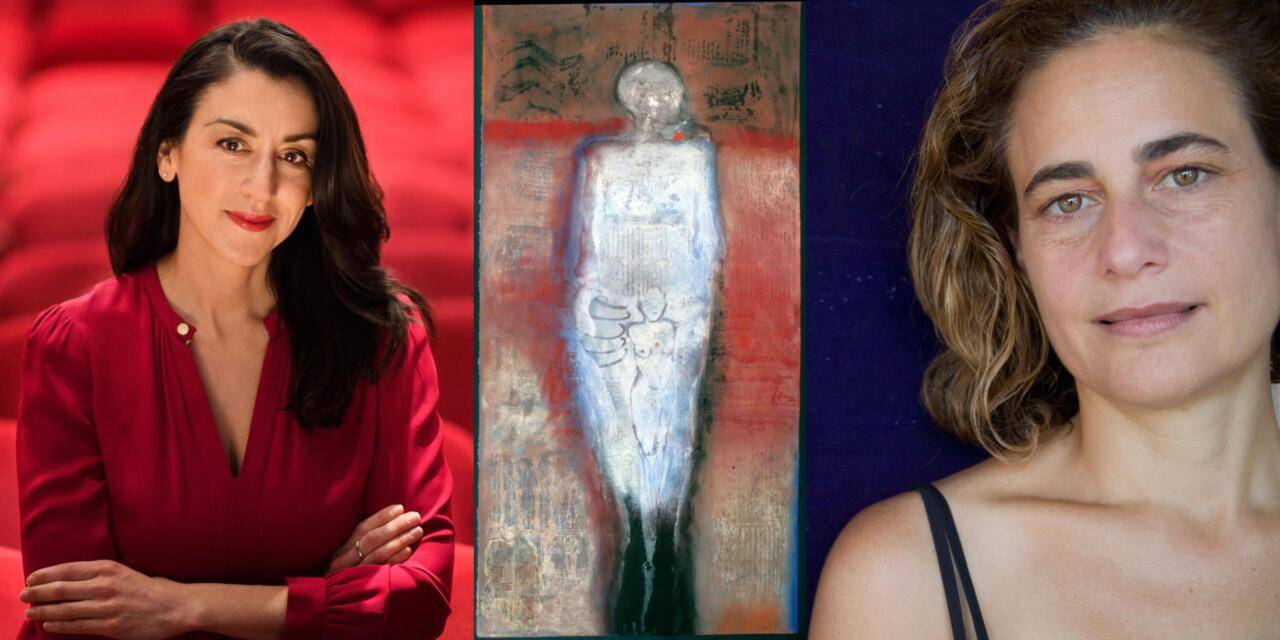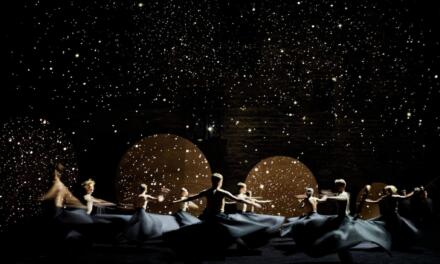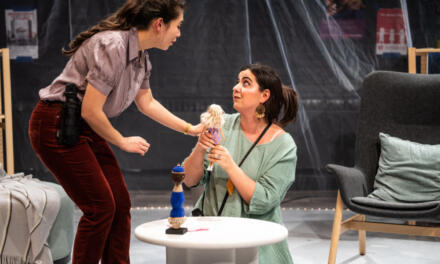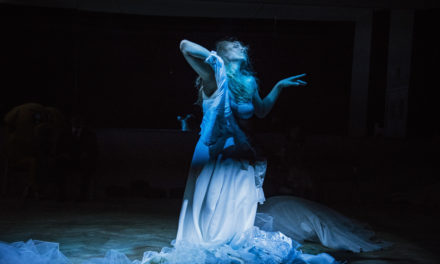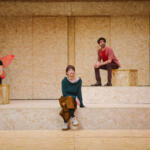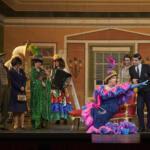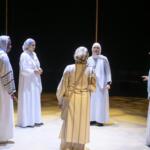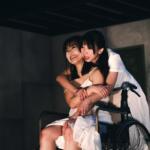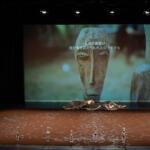Catherine Filloux is an internationally recognized French-Algerian playwright. Her work revolves around conflict, human rights, and violence committed against the female body: she has traveled the world to speak and learn from those within communities affected by atrocity. And what has she gained from her experiences most? Hope. Change. Friends and belief.
Filloux’s newest play, a one-woman show entitled How to Eat an Orange, surrounds the childhood of Argentinian artist Claudia Bernardi, growing up under the military junta and working to excavate the past. I was fortunate enough to speak to both Filloux and director Elena Araoz ahead of the play’s May 30th premiere at La MaMa.
Rhiannon Ling: I would love to first talk about, to both of you, what draws you to theater as a vehicle for human rights advocacy? Where does that passion lie?
Elena Araoz: Why don’t you start, Cat?
Catherine Filloux: I was going to say the same to you. [both laugh] Okay. Well, I think that, in a very general way, one could say that, because plays and playwriting are very much engaged in conflict, that along my journey, I have chosen to write about the most urgent conflicts, things I can write about at the time. And also, because plays take a certain amount of time—there’s the creation of the play and then there’s the production—I’ve always felt like I wanted to make sure I was working on something that had the legs to last and to be able to grow. So, I have focused on urgent human rights issues, and that has gone very well in hand with, for me, writing for the theater. And the other thing I would say is: my chosen job in life has been to be a playwright, and I have felt that telling stories through theater about human rights has been a way to communicate with communities of a variety of shapes and sizes that intersect, in all aspects, from the research all the way to the audience.
Araoz: I think for me, I have become very much a believer that theater does not actually teach empathy. I don’t believe that we actually go to the theater as an audience and say, wow, I feel so much closer to the characters on stage, I feel like I understand them innately. I think, instead, we go to the theater to learn about ourselves, that we watch people in difficult circumstances and we say to ourselves, what would I do in that situation? That, to me, is a deeper connection, because you’re imagining a life that you don’t have, whether that’s good or bad, depending on the play, and deciding for yourself and learning about yourself and what kinds of decisions you would make. And so I believe when you’re talking about themes as big as this—human rights, human rights violations, political trauma, trauma to the body—that you’re putting yourself and your own mind’s eye in what you would do and then therefore what you maybe should do. What should we speak up about? What should we stand for? What do I stand for? And I think that what Cat’s work does is it doesn’t give any answers. It just posits a lot of questions about what happens when people live in particular circumstances. And then we go, what if I was living in that circumstance? What do I do, or what can I do? And I also think that it’s very easy to go about life and not think about anything of importance. It’s really easy to, you know, order the stuff you need on Amazon, walk down the street, get the food that you need. Yes, all that requires money, but it’s very easy to go through the day without really activating any bigger consciousness than your small little bubble. And I think that plays like the ones that Cat writes—and this is my second one to work on with her—is that you are immediately immersed in bigger questions. And I think that it’s the beauty of what theater does, but specifically what her type of theater does.
Ling: So the artistic move into this semi-politicized genre: did it feel inevitable? Especially for you, Catherine: was it something that was very natural, or was it something that you made a conscious decision to do?
Filloux: Oh, very natural. Yeah, based on my philosophy of life that has grown through the years.
Araoz: You know, it’s a great question, because I’m the person at the party, when everyone’s talking about something that has absolutely no consequence in the world, I’m the one who’s like, let me just land some really provocative, horrible question into the room and see what happens. I think I get that from my dad, which drives my mom crazy, ‘cause my mom was like, can’t we just have a nice dinner? Why do we always have to argue about politics in the world and on all the different polarizing sides that we are on within one family? And I just love it. I just love being in deeper conversation with people. I feel like I get to be more in community with someone when I know what they’re really thinking about and how they would face a problem or what they think about the world. And so I am very attracted to plays that will do that, that will just invite an audience in, land a big question on them and ask them to be a part of the conversation.
Ling: Beautiful. Keeping on the same broader topic, especially with Catherine mentioning her life experiences and the philosophies that have come out of them: I have noticed that the two of you are fairly international folks. You’ve been all over the place, worked all over the place, and I’m curious as to how those experiences inform your processes or your art-making.
Filloux: For me, at the core, my mother is from Algeria, and her family was there for many generations—which is, as you can imagine, a complex geopolitical realm to have been in—and then my father was from France, the center of France, this is a guy who sailed a catamaran across the Atlantic. We ended up in California, and we would do a lot of camping: we would set out in the car to Mexico. So from the beginning, I was just set in a world where it was an international canvas, which was fairly idiosyncratic. That was just based on the history of what happened: my dad’s father fought in World War One and World War Two and survived. So these are histories that are based on war and repatriation and also language, the first language was not English. So, that, that just puts me into an international kind of world. But also I’m an American, you know. I have written in English. I’ve spent my life here, working in the United States and sometimes going elsewhere. So I look at the canvas as being very much [both] national and international.
Araoz: What I love about traveling, and specifically making art in other places and making art with people who come from those places, is how much I learn. It’s always this reflection of the self. So much [that] I’ve learned about myself and America and where I’m growing up and where I am now, where has always been home is what and where, what locations, what places, what value systems create what is allowed to be spoken about and what isn’t allowed to be spoken about. And what are certain cultures and subcultures prudish about? What’s taboo? What is funny in one place that is disrespectful in another? All of these things I find—
because those are the details of drama; because those are the details of a sense of humor; those are the details of a literary tradition; those are the details of class and society and community—those are the things I love to absorb and find. So much of my work is about labor and class. I’m particularly interested in putting that on stage. And I think most of American theater tries to ignore labor and class, specifically manual labor. And I also am constantly, in other countries, having my own sense of beauty challenged. I don’t necessarily mean physical beauty, but the way I talk about theatre-making and when I’m talking to my students, for example, I always say, for me, what makes theatre so impossible, and what we’re all working towards is, to make something truthful and beautiful. Now, beauty, we all know, is in the eye of the beholder, and in some respects, so is truth, but we’re trying to make something really human, the beauty of humanity, the truth of humanity. But then you might go someplace that feels very different than the place that you live and you think, wow, their sense of what’s beautiful is so radically different. I’m also very inspired by countries that I’ve been able to make theatre in, or countries that I’ve even been able to just observe theatre in, who don’t come from this Western culture that makes us sit in a dark room quietly and receive a message. I like going to places where talking, responding, throwing things, are all part of the expectation of what it means to go to theatre. My father is from Peru and when I’m in Peru, I’m always watching street theatre. [In] most Latin American countries, you make theatre with scraps. There’s no like, oh, let’s go to the shop where all the props are located. It’s: what do you have? And you use those things to make theatre. And so I really love watching how theatre can be everywhere and anywhere all of the time, because it doesn’t take money and it doesn’t take things. It just takes people and imagination and a story. And I’m particularly invested in the way protests in Latin America always involve theatre. There’s always performance in any protest.
Ling: Out of pure interest, are there any stories of your travels, either of you, that really stick with you to this day?
Filloux: I was just gonna use your question to speak about something that is in relation to that. I think for me right now, after I’ve traveled all over the world, I’ve been to a lot of conflict areas and [have] had a long enough time, I feel, to really see some trends in the world….Violence against women is just rampant, everywhere. And PTSD, something that I started researching and writing about in the early nineties, which, back then, it wasn’t an acronym like it is now. And I come away from my travels with the idea, very strongly, that change is possible, and that I can see it. I can just see it. I can feel it. The sum total of what I’ve experienced makes me believe it. And it ties into, for example, this play. In the sense that I believe that this play and the character it’s based on is full of hope, and it dawns on me that –perhaps people in the theater and in the climate think that hope is a sentimental thing,
and for me, it is absolutely not. There’s a difference between hope and sentimentality, and maybe that’s what this play has to say more than anything, and that I would tie it to. For example, going to Cambodia over and over again and seeing that my friends who are the artists [there] stayed at the same poverty level the entire time that I went for decades, whereas there was an economy that was the economy of the corrupt, which exists here in our country, as well. And the last time I went there, I got a grant, a typical US kind of grant, and—I say this not because I’m a hero, but just because—I cashed out the grant, and I gave it to the artists, because I don’t want to be part of, even to a degree, that sentimentality of like, Oh, we’re just gonna do this thing of art. No, no, no, no. So, there’s my little story.
Araoz: I’m really fascinated by how, when I go to many countries, art is everywhere and it’s part of daily practice. So, for example, when I go home to Peru, if you go to someone’s house, and they’re having a dinner for you, it would be 100% normal, expected, and socially required that at the end of the meal, you will deliver some kind of performance. You’re still sitting in your dining chair, but you might sing a song, you might recite a poem, you might pick up a newspaper article and read it out loud for everyone. So the idea of art as [a] practice of daily life and a way to disseminate information and to disseminate beauty and truth is everywhere. When I was in China, I would get up really early before rehearsal and go for walks in all the parks that I had access to in Beijing. And I would watch the people practicing their string instruments, I would watch the group of people practicing ballroom dance or practicing the fan dance, and just seeing that that practice brings fullness. And I wonder if we always do that in America. Yes, there’s art everywhere – we live in New York City. Sometimes I’m most excited by a piece of graffiti and the message that it says. Art is everywhere, but are we always, everyday, practicing that in some place? I also think that my aesthetics and how my understanding of what beautiful is is constantly challenged or re-evaluated when I’m traveling. I was doing a show in another country, and the costume designer showed me a costume for what was supposed to be a very beautiful, regal costume. And I was like, Oh my gosh, those colors don’t even go together. And I realized I offended everyone in the room because those colors, in that culture, 100 percent go together. They are a beautiful combination. And so, you know, I apologized. And I’ve learned a lot. I’ve learned that what I grew up thinking beauty is is not a standard. So I’ve learned to be open and listen more than talk.
Ling: Let’s move into How to Eat an Orange, shall we? I see from the press release that this play was originally commissioned by INTAR. Is that correct? How did that partnership come about, and how has the play’s evolution looked since then?
Filloux: So I know Paul Slee Rodriguez, who was the managing director at INTAR, and I mentioned the project to him, and he thought it was good, and so they commissioned it. And then it became this really interesting foursome of people: the woman who it’s based on; Mercedes Herrero, the actress; and Elena [and me]. And we wrote. I wrote it for Mercedes and then we decided it was…I guess we could safely say it was during the pandemic [that] we decided to do a virtual workshop of it, and we never saw Mercedes once. She was in Virginia. We never saw Claudia [Bernardi, whom the story is based on]. And Elena brought on her stage manager, Milan Eldridge, who’s doing it again, and Milton Cordero, who’s our projection designer. And I think it would be safe to say [that] we kind of made it collectively. I mean, I wrote it and Mercedes was nice enough to, to say it out loud and stuff. So it’s an interesting process, for sure.
Ling: Yeah. Elena, do you want to speak to that at all?
Araoz: I was doing a lot of virtual work during the pandemic, still am, and it was wonderful because we got to really know the play. Cat’s work can really feel like a puzzle that needs to be figured out: it’s like a Rubik’s cube in a way, and you gotta find the ways that it all matches up. What was great about that time is we had all this time online, and we were able to really un-puzzle and then re-puzzle when we wanted to [in] the script and the text, and really understand all of the meanings behind a paragraph, a sentence, and also because it’s based on a real person. It’s based on a real place. It’s based on real trauma and real politics and calls for justice. [The pandemic] gave us that time to do a tremendous amount of dramaturgical research and historical research, and [let us get] to know people. The woman that it’s based on, Claudia Bernardi, is an artist. We got to know her artwork and a little bit about her practice. All of that is infusing into this now-live production with a new actor, so I feel like we we’ve come in with so much of the job done.
Ling: How do you approach, at least in this text, dramatizing the true story of a real human? What is your approach to that?
Filloux: That’s a great question. I think it’s important to start by saying [that] this is Claudia as a character on stage, to distinguish the two. This is not a real person, this is a character, let’s say. And I think it’s interesting, in hindsight: it seems to me that, during the workshop, we did a certain amount of checking in with Claudia and, even after the workshop, I got some notes and did more work. And now we’ve really kind of moved more into this being a theatre piece, and it’s obviously completely separate from the real person. I wrote an opera for Houston Grand Opera—that I was commissioned to write—that was supposed to be based on a woman in Houston, who was a kind of local hero. She came to the show, and she came to the dress rehearsal. So I’ve had the experience of doing that before, and I think that was useful because it is kind of an interesting additional thing to have happen.
Araoz: And I think any piece of art, definitely any piece of theatre, does involve an expectation of fiction. Yes, it’s about a person, but it’s not a very long play. It’s actually a quite condensed one act play. So there’s only so many aspects we can show, but also it’s very unrealistically staged. So that, I think, opens the door for the audience, which is to say, you’re seeing snippets of someone’s life who comes from a history living through political, social unrest, and coming out of it and finding hope in that. Not to say that that’s what all the play’s about. It’s based in reality but told in a magical way, and it’s the combination of that that I think makes it theatre, as opposed to a speech or presentation about someone. It gives us real leeway to explore what we imagine someone is going through when they speak words, or what they are actively doing to move forward in the world. That’s what’s fun is that
practice that we all need of: how do we keep moving forward in space? How do we make the world a better place? How do we find love and kindness? So that’s what so much of rehearsal is about, is finding those actions that pull somebody out of despair even when circumstances are difficult. In that way, it becomes almost a dance. It’s about watching somebody live life through difficult circumstances.
Ling: Something that drew me to this piece immediately was the use of the verbiage “a piece of excavation” to describe the play. I would love to hear from the two of you a little bit more about that wording and how the story does just that.
Filloux: Well, thematically, it is about excavation insofar as there’s some forensic anthropology themes that have to do with uncovering, let’s say, mass graves, and I think there are other ways that it’s about excavation. But I was going to say that watching Elena work, which I had a chance to do on my last play: sometimes you work with someone and then you have a chance to do it again and then you see, oh yes, this is her signature, she does this, and [Elena] is an excavator. Very much. And I love that. For me, it’s very special because I am very committed to language in my plays in a way where there’s layering involved. So that’s the similar to excavation in the sense that everything does not have the same weight, and you need to dig on one level, so you have different stratas. And, and the last thing I’ll say about that is that—not to sound sentimental, since I just said that’s a bad thing to me—I have to say coming back from not having had the chance to do live theatre as much, it’s very moving to me to see how people can work in live theatre. I’m very humbled to watch my collaborators excavate.
Araoz: I have come also to believe that…so a person might go to a therapist to dissect their psychology: why do I have this reaction in response to this? And I find that a theatre artistic team—actor and director and designers together—are actually building the psychology of a character. They have to build the thoughts and histories and pasts, in order to have those reactions. And they have to be really specific so that a theatrical, over-the-top reaction still feels real and truthful. So I actually feel like when I’m helping artists, specifically the actors and the designers with them, anybody who has a say in building character, that we are actually layering the psychology of someone. And then, the audience can deconstruct that person. And this character, this person that it’s based on, is an artist who layers their painting with many different materials and many different subjects, which seems to also counteract the forensic anthropology, which is the unlayering or the trying to discover. I’m really fascinated with the way language, design, movement, is both either a revelation of a secret or the hiding of a secret, and how those are active things that we all do and so our characters should do, too.
Ling: So: why this piece now?
Araoz: Well, I will say, when we started working on this after [what] Cat wrote based on the INTAR commission, it did not feel at that moment as intensely relevant as it feels right now.
The play touches on ideas of complacency, political complacency. It takes on ideas of complicity by a public’s silence or acquiescence. It questions what Latin America has been dealing with for centuries, questions of dictatorship and how easy it is for dictatorship to just overcome a society without them even knowing it.I think that that’s something that America is really trying to wrestle with: how do we protect democracy? How do we protect our democracy when we’ve done so much to destroy other democracies? I’m specifically talking about Latin America, but that’s happened in other places, too. And, you know, we’re talking about how communities heal after the devastation of war and how—and this is one of the most beautiful aspects of the play, is really positing this idea of after a war, you don’t just reconstruct what you were. You have to reconstruct with the ramifications of what’s been lost. So thinking about the wars that America is fighting, helping, assisting, sending arms to, I think the play asks a lot of questions about our global impact.
Filloux: I think everything that Elena said is exactly right. And actually I have something here that I think would be useful to show. [she shows a model of a hand grenade] I was hoping to put this hand grenade into the show, and Elena had a negative reaction. But since I’m not going to [put it in], I can show it right now. I think that sums it up in terms of why now. It’s a ticking grenade. And Claudia had this thing that she said where, in something she wrote more recently, I think, where she was just like, there was this hand grenade and it was detonated and it was there, but I just would step around it, but it was completely detonated.
But now, [she doesn’t] think it was. And it’s ticking. And we are, too. People should just come see the play because they will understand why now. We are in a period [where] we are questioning things in the US very seriously, and I just am so positive and hopeful that there are some people on the horizon that are going to be great changemakers. I place a huge amount of hope in the people that are going to listen to the ticking of the grenade and are going to say, We got this. We’re gonna figure out a new way.
Ling: Now, where can we find the two of you? Is there any website, social media, anything you would like me to plug?
Araoz: Yeah! You can find me on my website, which is www.elenaaraoz.com, or on Instagram. I also want to mention one thing about the play: our performer is astounding. Her name is Paula Pizzi and she is Argentinian, just like the character that this is based on. She now lives in the United States, just like this character. They’ve both become artists.
And the thing that Paula mentioned was, when she read the play, how honest it felt, how connected she felt to it, and even though she’s younger than the character that it’s based on, it brought up so much of what her society, her community, her family had lived through that she felt like she had to tell the story, and that honesty is so clear in her performance.
I mean, I’m just amazed watching her every day. She just brings so much to it, because she has so much care for the story.
Filloux: Yeah, I agree. And I’m at www.catherinefilloux.com. And How to Eat an Orange at La Mama should be pretty easy to find. [all laugh]
Ling: Brilliant. Thank you both!
How to Eat an Orange will run at La MaMa from May 30th to June 16th. For more information, and to purchase tickets, click here!
This post was written by the author in their personal capacity.The opinions expressed in this article are the author’s own and do not reflect the view of The Theatre Times, their staff or collaborators.
This post was written by Rhiannon Ling.
The views expressed here belong to the author and do not necessarily reflect our views and opinions.

